Last season’s Serie A champions Inter Milan have jumped into a new challenge with a managerial change that will make their title defence journey even more intriguing. Antonio Conte left after helping them win their first title since 2009/10 with José Mourinho.
After his departure, Inter introduced their new manager, Simone Inzaghi, who left Lazio after five years with the club to help in Inter’s development and push them to not only defend their title but also to lead them to better results in the UEFA Champions League.
Inzaghi has established himself as one of the most promising Serie A coaches in the last few years and arrived at San Siro after a rather successful run with his ex-club. Being Conte’s successor seemed like a logical decision, bearing in mind their respective coaching styles and strategies that have some similarities.
Predicting his tactics and performance, though, was difficult due to the few player departures during the summer that left Inter in a difficult position. Their best performers Achraf Hakimi and Romelu Lukaku left the club going to PSG and Chelsea, respectively. Both players were crucial in Inter’s title run last year and it was difficult to imagine the team repeating their achievement in their absence.
Luckily, the team made some good moves on the transfer market and saw the arrival of Hakan Çalhanoğlu, Joaquin Correa and Edin Džeko, who all proved their quality with their previous clubs.
Now, things look better for Inzaghi who made sure to build on the title-winning team instead of switching to an entirely new strategy. This decision might prove crucial in their 2021/22 campaign as he will only try to enhance their performance by implementing his own beliefs.
This tactical analysis examines Inzaghi’s tactics and how Inter look after their first few games of the season.
Current squad and formations
Inter are in a better position with their squad depth at the moment, although they still need to strengthen in some positions. While their potential starting XI looks complete and well-packed, their bench isn’t as impressive, although they do have some solid replacements in the advanced areas. The team doesn’t have many backup options on each position, which might affect their future performance in case of injuries and considering their participation in a few tournaments.
Starting from the goalkeepers, the first-choice keeper is Samir Handanović who is now 37 years old and coming close to his 10th year wearing the Inter shirt. The Slovenian player conceded the fewest goals in Serie A in two consecutive seasons and is still expected to be a regular starter for the team. His backup is the Romanian Ionuț Radu, who just came back after a loan at Parma where he didn’t get any playing minutes. The lack of experience and regular playing time could be a problem for the Nerazzurri in the future, as there is no real competition and quality replacement for Handanović which is rather risky with the intensity of their schedule. The third option is the experienced 38-year-old Alex Cordaz who joined from Crotone.
Inzaghi continued Conte’s back-three legacy, sticking to the same set-up that he actually favoured at Lazio too. His centre-back options are rather limited though. Milan Škriniar, with his solid displays, is expectedly the regular starter in the right centre-back position, while the backup option for his position would be Danilo D’Ambrosio. Matteo Darmian is another option but he is more likely to start as a right wing-back.
Stefan de Vrij plays in the centre of the defence with Andrea Ranocchia available for that position too. Ranocchia only played around 700 minutes in Serie A last season and replacing the crucial De Vrij might come as a challenge.
Alessandro Bastoni is expected to be the regular starter in the left centre-back position with the experienced Aleksandar Kolarov as a back-up, although his approach to the game is way riskier. Federico Dimarco is another option there, although he might be preferred to play in the left wing-back position.
Some of Inter’s defenders are interchangeable which makes Inzaghi’s life easier.
As mentioned, Darmian will cover the right wing-back with another new signing, Denzel Dumfries, being a decent additional option there and showing huge potential in his first few games for the team.
Inter look a bit more versatile centrally, although Marcelo Brozović seems irreplaceable in the defensive midfield position at the moment. He can be replaced by Stefano Sensi and Nicolò Barella if necessary, although they seem to be more beneficial in more advanced positions.
Sensi and the new addition Çalhanoğlu seem interchangeable in the LCMF position, while Barella, who is the regular starter at right centre-midfield, could be replaced by Arturo Vidal and Matías Vecino. Barella could also play on the left, with Vecino taking the right spot as they did against Bologna.
The left wing-back, who serves more as a winger, is Ivan Perišić, whose backup option is Dimarco, as mentioned.
It seems that the final third coverage is solid, with Lautaro Martínez, Alexis Sánchez, Džeko and Correa being pretty flexible in their positioning and interchangeable. They also have the 20-year-old Martín Satriano as an option in attack.
The current squad is built to fit the 3-5-2 formation, which is what Inzaghi sticks to with his arrival. Inter’s aim is to have control over the ball and have more of the possession, although they tend to give away the initiative and stay deeper against more pressing teams. The team do rely on short passing and involving all players in bypassing the press and progressing the ball.
Defensively, their approach is riskier than before, involving a more intense press and relying on winning the ball back in the more advanced areas. Their PPDA numbers have improved compared to last season but their new defensive approach has also resulted in an increased average number of fouls and yellow cards per game.
Ball progression
Inzaghi didn’t change the way Inter build-up from the back and retain possession by involving the goalkeeper (forming a back-three with him), who often combines with the defenders and allows the team to move into a more advanced position and help them bypass the press.
The three-man backline widens to allow the rest of the team to move into a more advanced position and have better coverage centrally to open the passing lanes and progress the ball. One of the centre midfielders (most frequently Brozović) drops deeper to pick up the ball and help the team escape the opposition’s first line of defence. He drops into the defence to offer himself to the keeper, while one of the centre-backs is positioned higher.
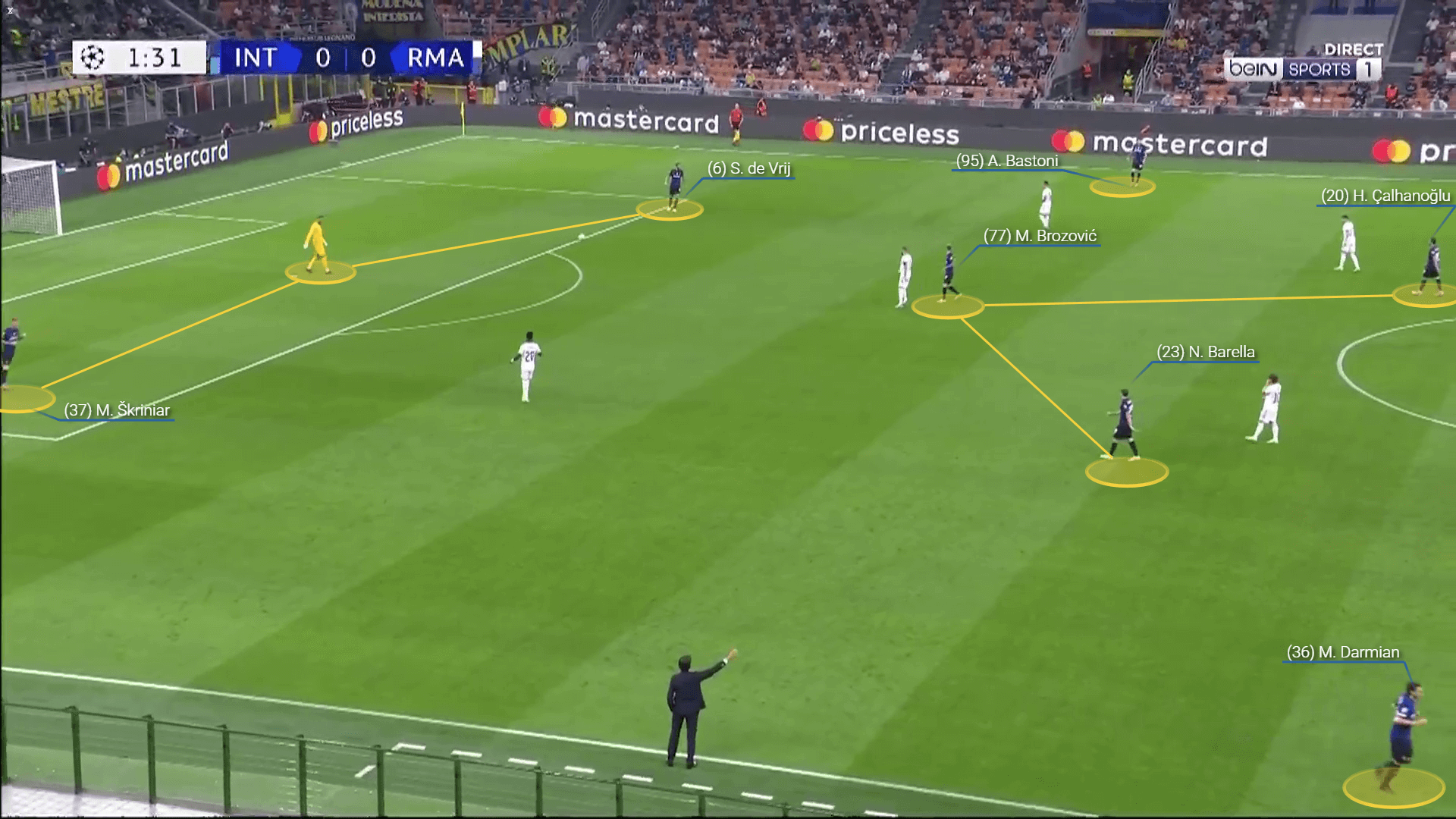
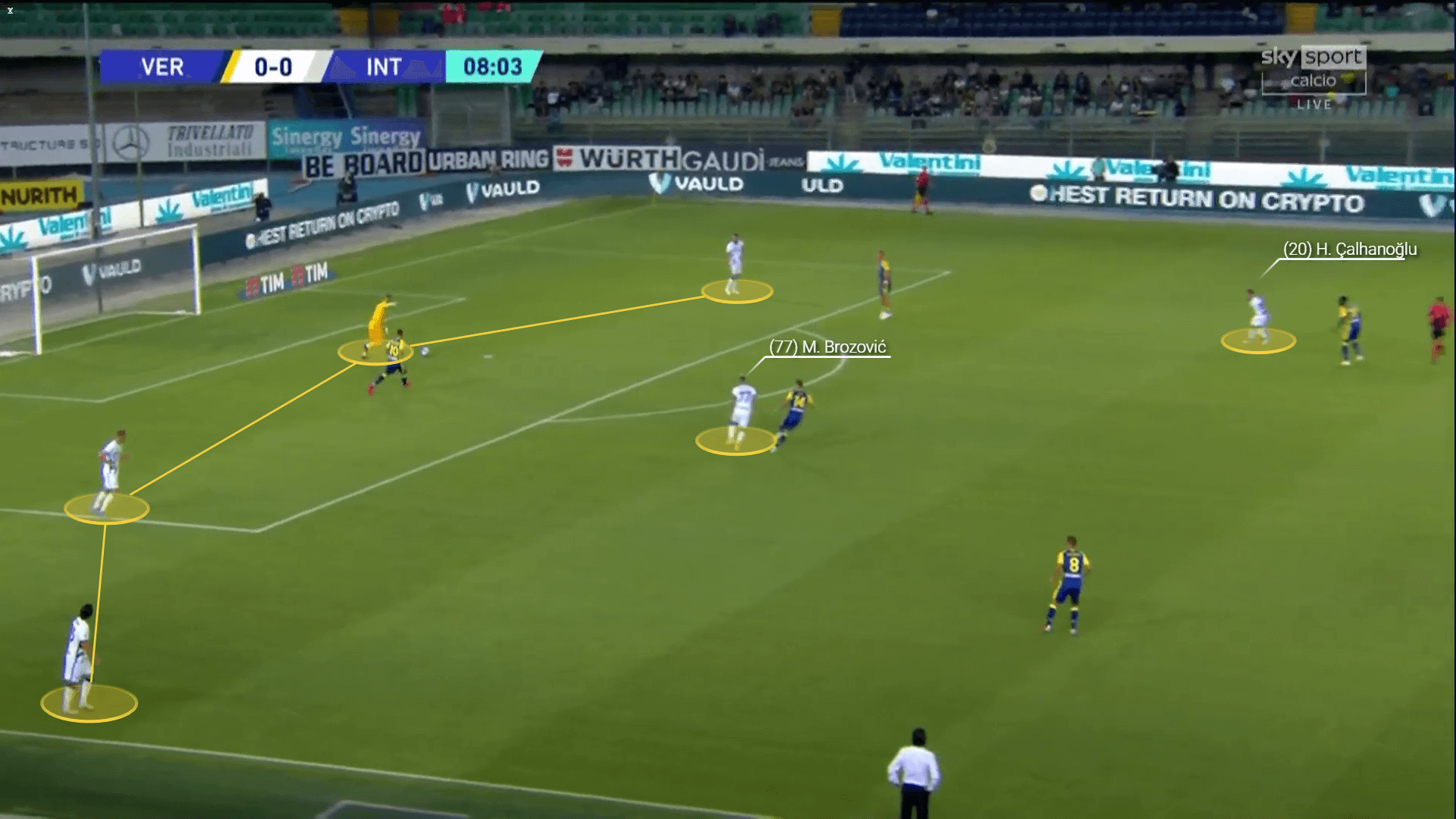
The wing-backs do offer their support too, although they mostly stay on the central line, and even higher, to be able to overload the opposition half and join the actions in the final third too. That allows the team to move forward quickly and progress the ball through all channels. They sometimes drop deeper to break the opposition’s pressing structures and drag players, freeing up space centrally.
The team use a lot of movement in their build-up play without clearly defined lines. Instead, each player often moves up and down the pitch to open the passing lanes and provide a passing option to do one-touch combinations and break through the press.
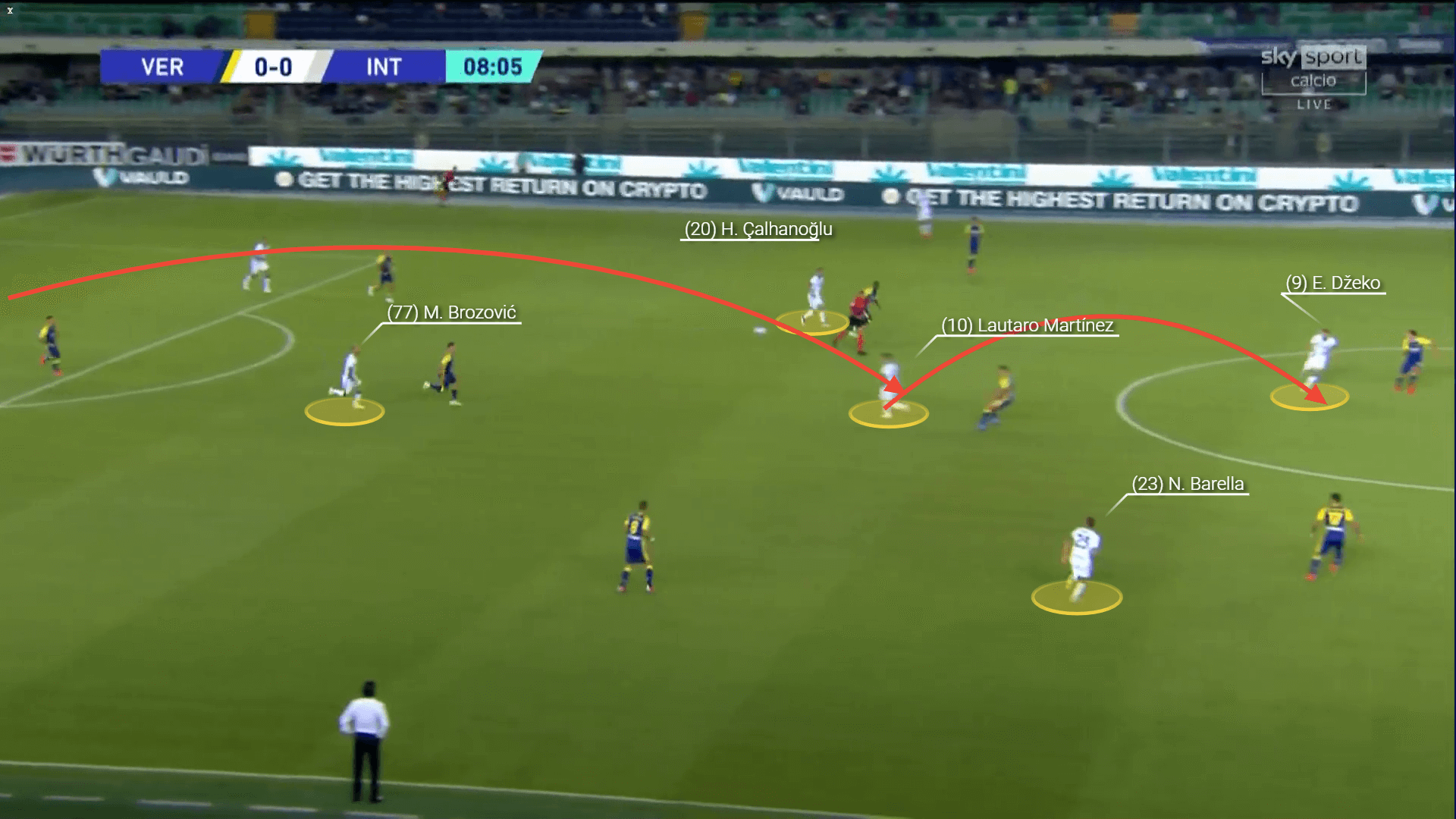
They do struggle to build up against teams that press them high. That’s when they involve the goalkeeper even more, which often proves tricky as Handanović’s decision-making under pressure doesn’t always provide the best solution for the team and results in risky actions in their own third.
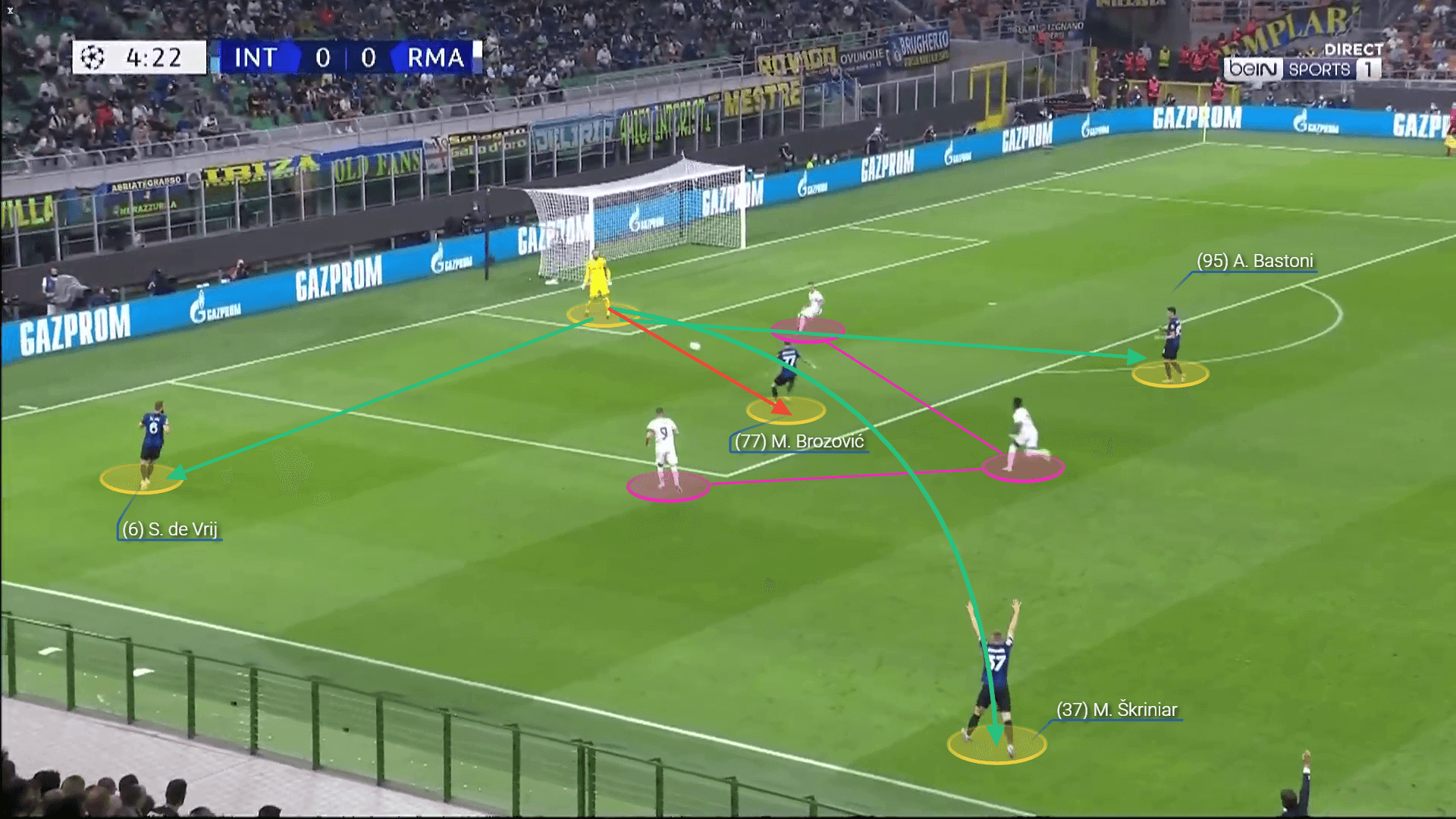
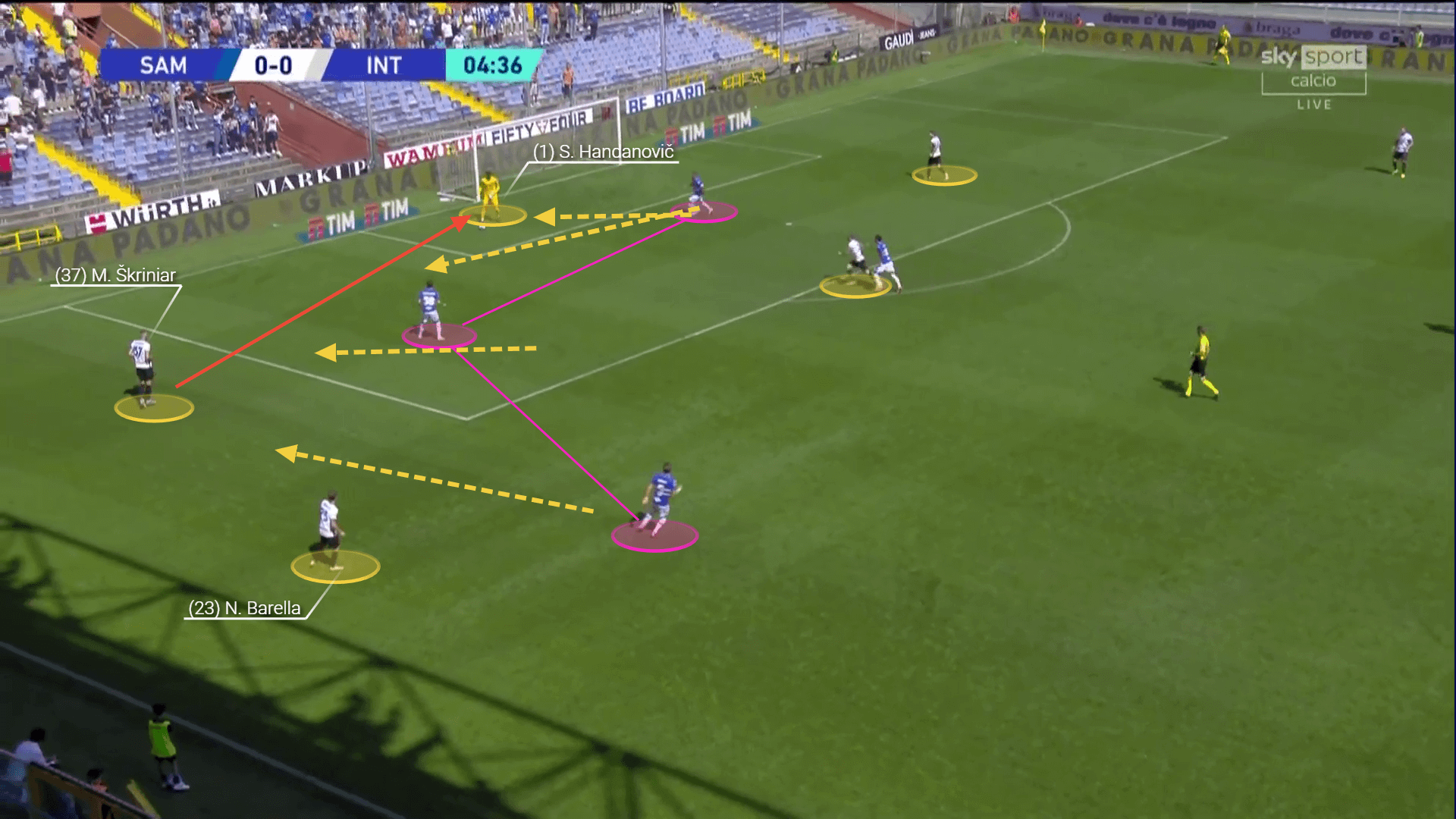
The Nerazzurri do play with width too, although their average crossing numbers have decreased this season. When building up through the sides, the players rely on link-up-play, as well as overlapping and underlapping runs.
Bastoni is the centre-back that moves into a more advanced position and supports ball progression with his runs where he can combine with Dimarco/Perišić and Çalhanoğlu. Then, one of them would go further and cross the ball.
They act similarly on the right, where Barella often offers a passing option and also changes positions with Darmian and Škriniar, trying to drag players out of position. The team are more active on crossing from the left, while on the right, they often use Barella’s advanced positioning to provide the ball to him so he can penetrate the defence.
Inter try to settle between the central line and the edge of the final third and often try to have more bodies between the opposition’s midfield and defensive line. That gives them numerical superiority and allows them to open spaces with their movement.
Final third movement
There is no doubt that Lukaku was Inter’s key player last season but his departure doesn’t necessarily mean that the team would struggle in attack. In fact, having Džeko, Correa and Martínez makes them more versatile in the final third and gives them a different perspective as they are different types of forwards.
The team either moves in a way to free up the midfielders who can advance the ball or looks to stretch defences to the wing and create 1vs1 situations to try and have more people move off the ball to the box to create a numerical advantage once they cross. The Nerazzurri rely on a lot of movement in the advanced areas. Whenever they don’t focus on penetrating through their crossing, they tend to create attacking triangles and break defences as they open spaces for each other with their movement, using one-touch passes to escape the pressure and get into a goalscoring position.
The players also don’t hesitate to shoot from distance. As we mentioned in our Çalhanoğlu scout report, he brought additional threat from outside the box with his arrival and could increase the team’s efficiency in attack. Their movement often frees up space for shots from distance. In each case, they commit more bodies to the attacking actions trying to always have a numerical advantage in and around the box.
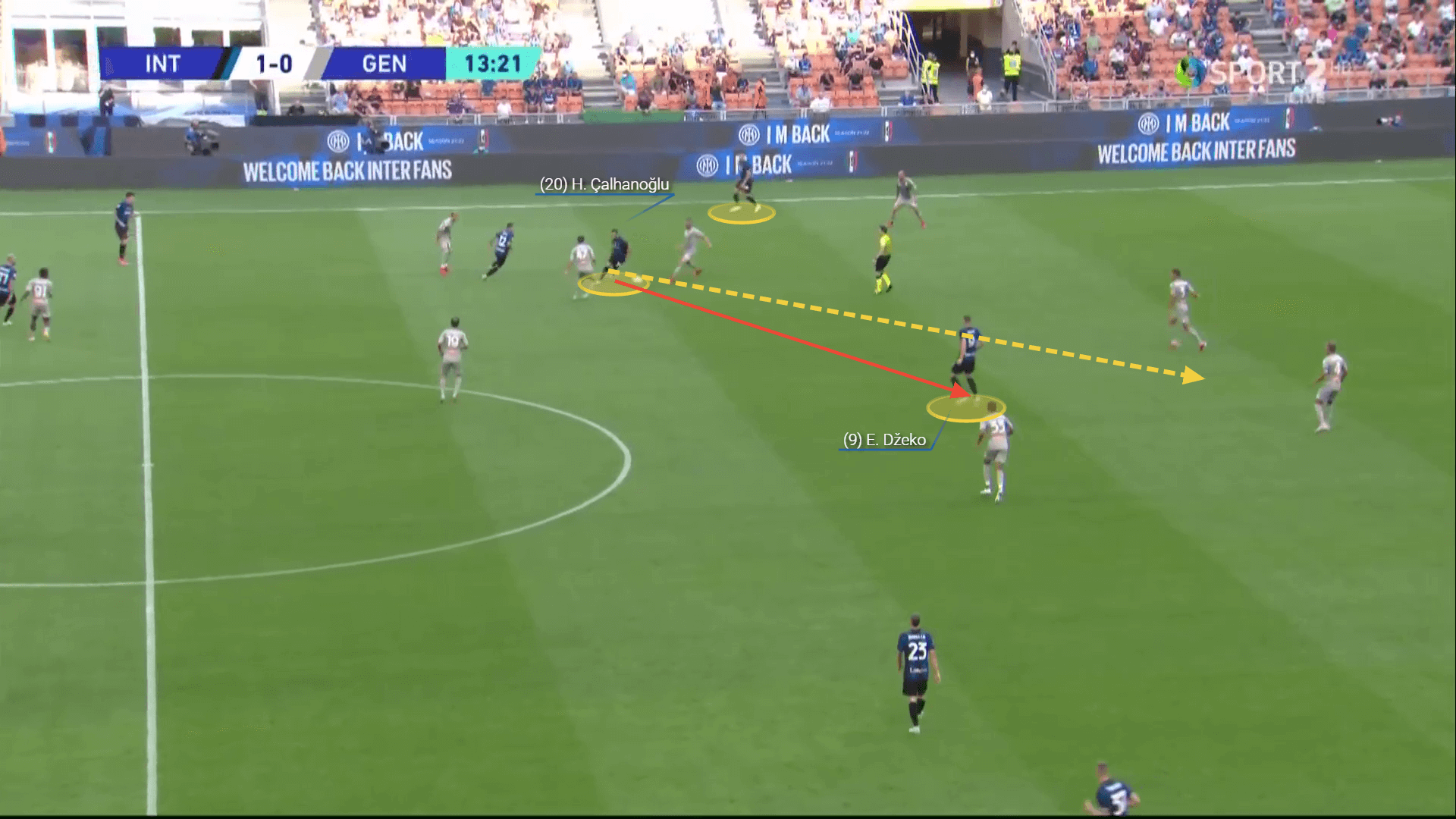
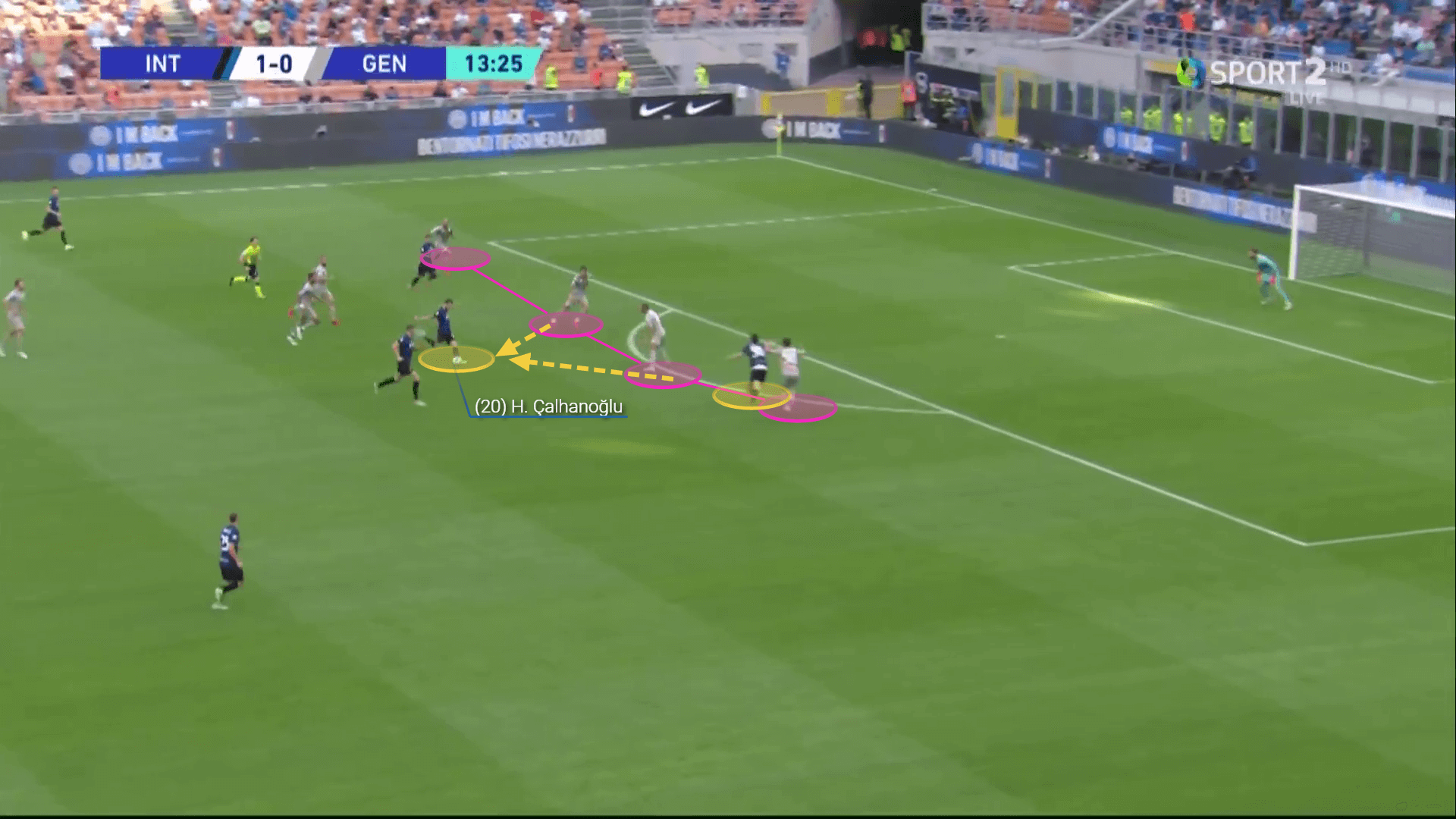
They also frequently rely on a switch of play if the area around the ball carrier is overcrowded and exploit spaces through their speed. The Inter players’ off the ball movement is smart and often results in successful headed attempts. Five of their first 15 goals this season were scored with the head after either a cross or a corner.
The team are proficient in counter-attacking under Inzaghi too. Whenever they manage to recover the ball, they don’t miss an opportunity to catch their opponents off guard. They use Martínez’s and Barella’s speed to counter, and the Argentine is often the player to utilise these chances. Another player that performs well on speed is Dumfries, who contributed to a couple of Inter’s six goals against Bologna. His runs both on and off the ball could be beneficial for the team in the future.
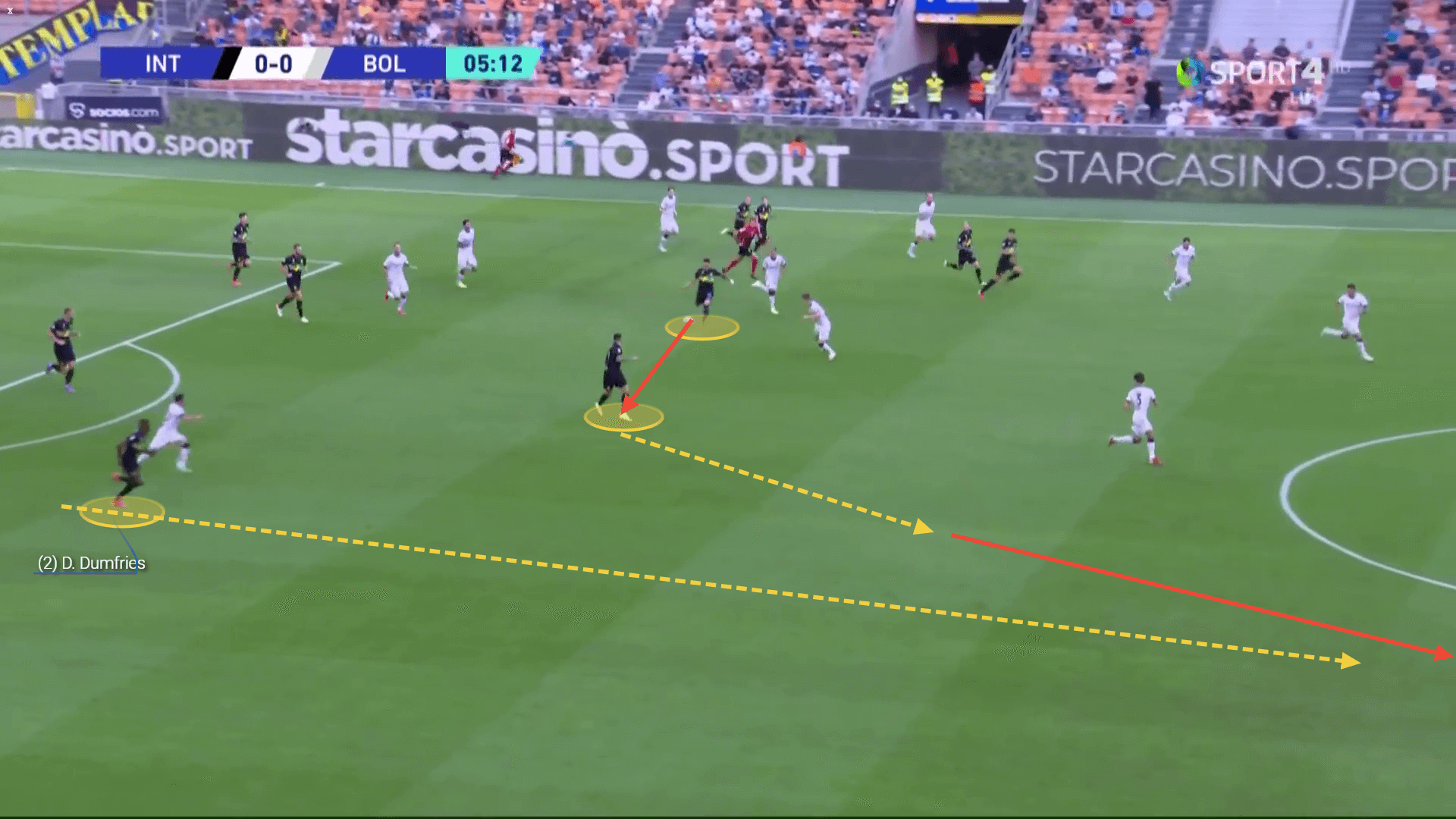
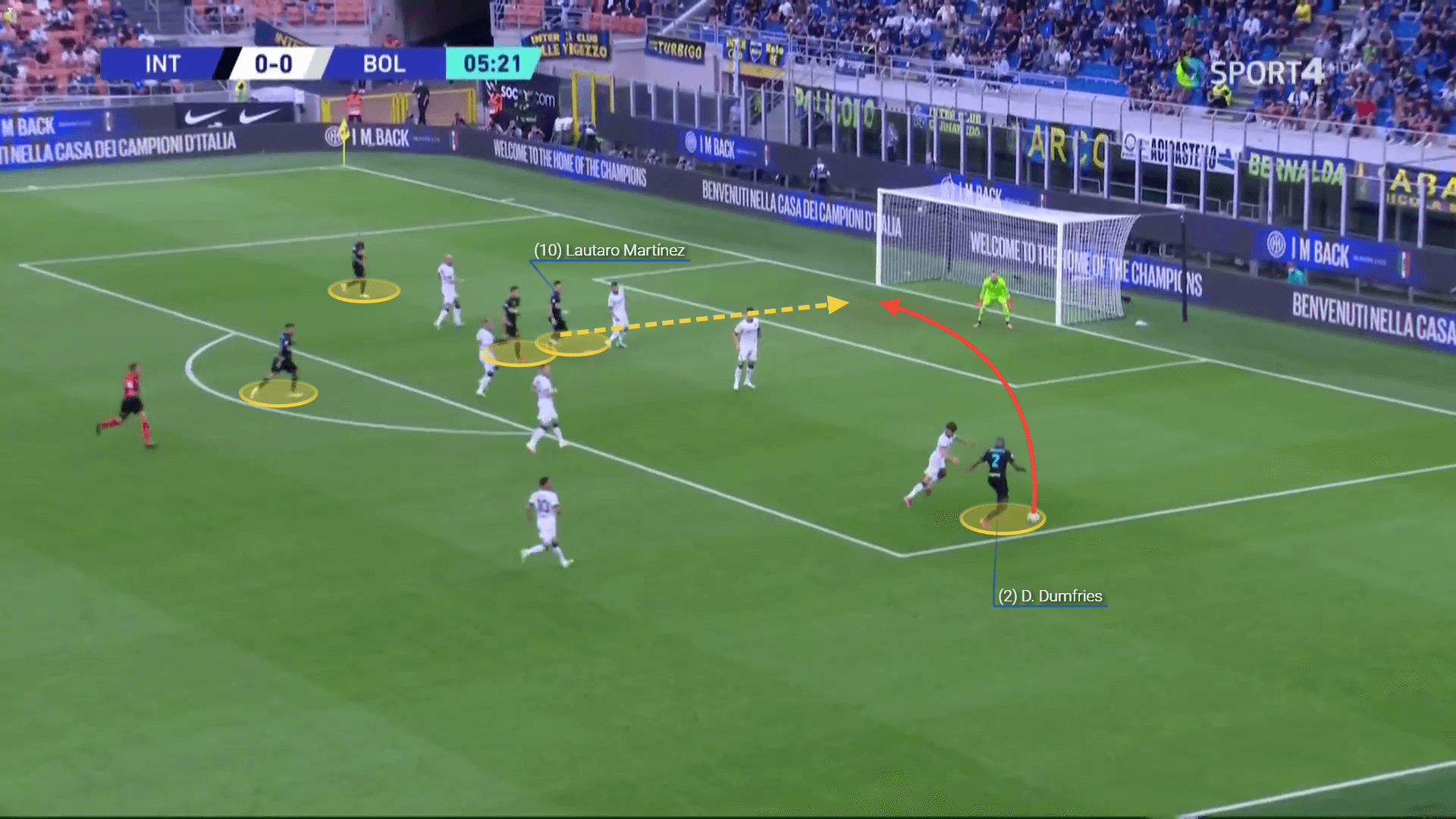
Pressing efforts and defensive transitions
As mentioned, the Nerazzurri’s press intensity has increased. The team now apply a more aggressive man-to-man approach which does help them in pressurising the opposition and forcing them into losing the ball but also possesses greater risk.
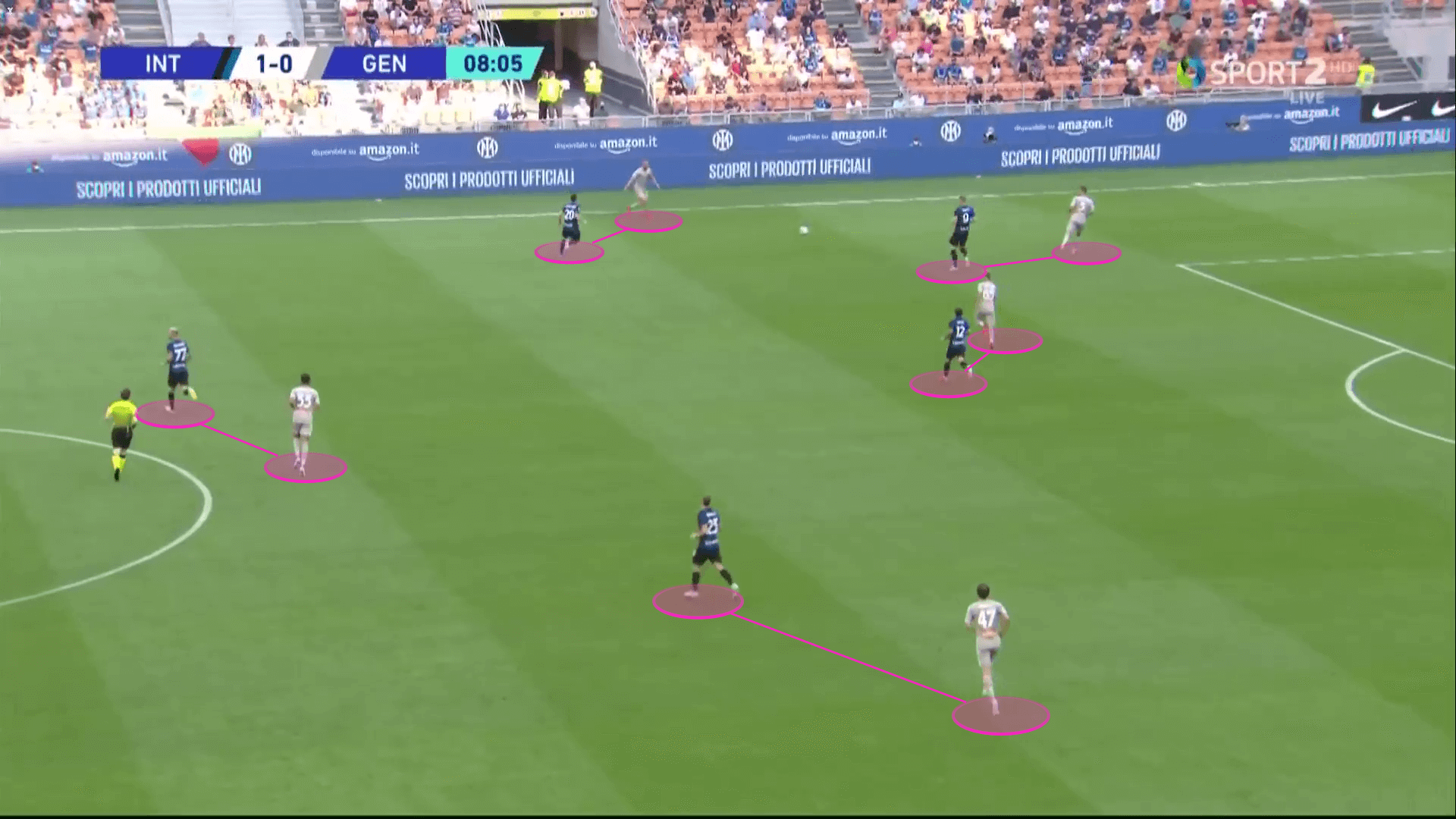
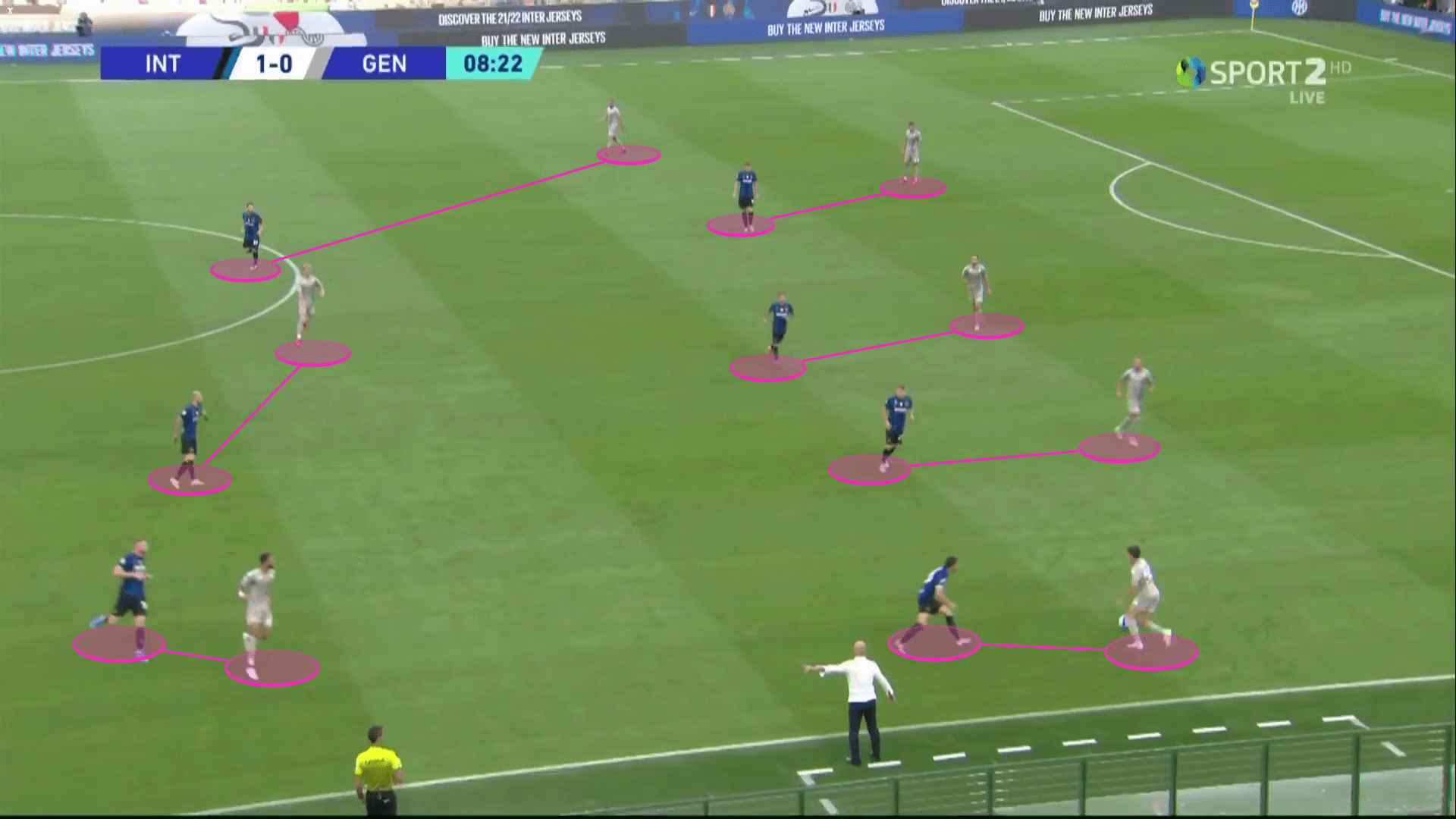
The team is now more vulnerable should the opposition escape that press as the players need more time and effort to regroup and defend as a unit. That means that they are more prone to depend on the individual performance and actions in these situations, rather than the collective one. They don’t press too high, though, but prefer to focus their actions in the midfield to minimise the risk of leaving too much space behind the backline and avoid the aforementioned situations.
In the cases when they counter-press immediately after losing the ball, they increase their awareness and make sure to have the defensive line in place in case the opposition manage to bypass the initial press.
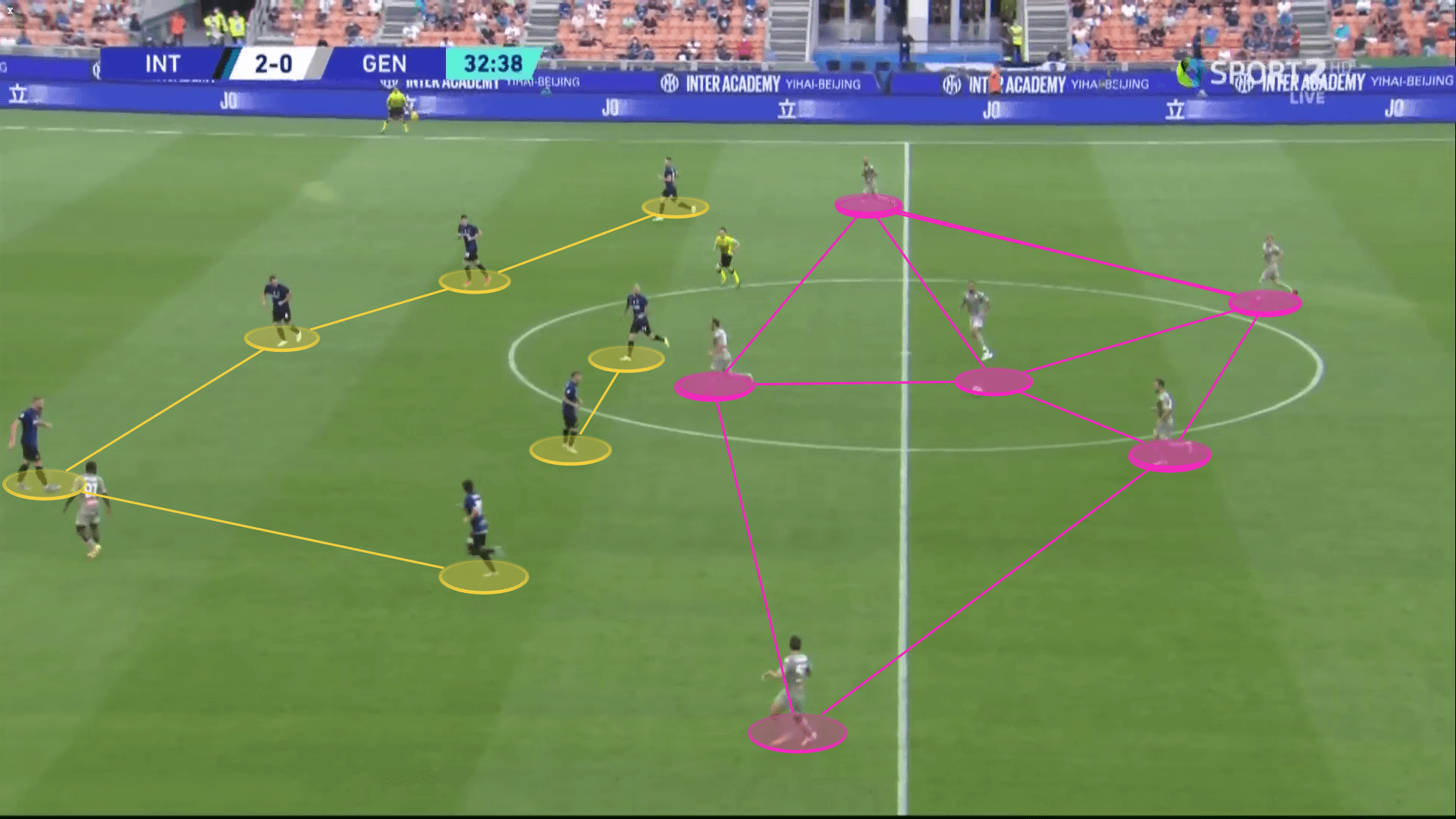
Most of the time, they manage to change their defensive structure should the opposition get into their half. Brozović is often the first one to join the defensive line, especially when it comes to closing out space or being caught on a counter.
The players try to limit the ball carrier’s space for movement as much as possible. Whenever they commit more players to him and move away from their man-to-man marking, the team increase the risk of leaving more free spaces. They have a more aggressive approach in terms of physical challenges too, as they create 2vs1 (and also 3vs1) situations, surrounding the ball carrier, especially when moving closer to their defensive third.
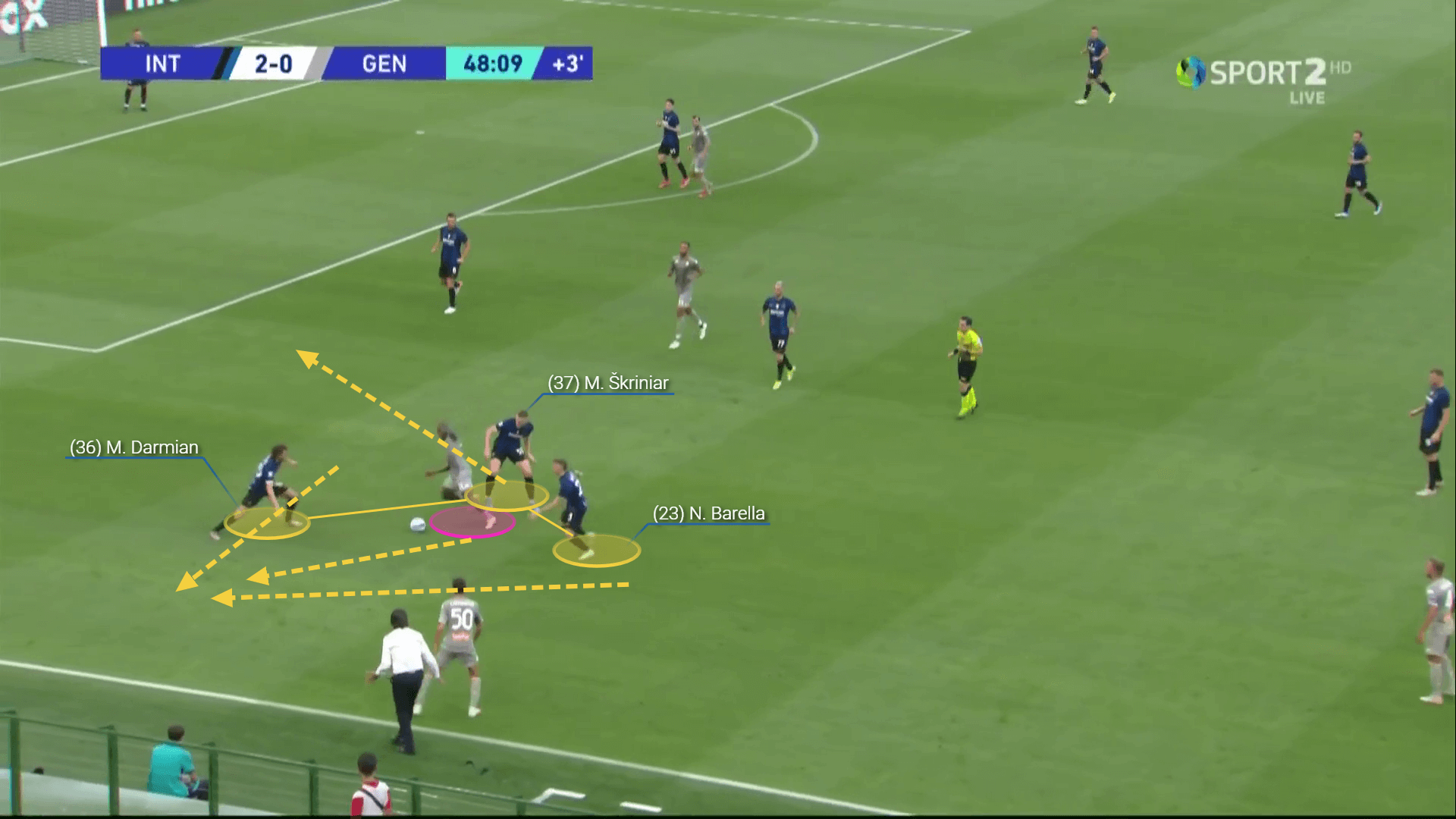
That, though, requires better support by the midfielders who have to cover depth or step out to cover the ball carrier so the defenders could go back to their position. That happens more frequently when defending the wide areas where they not only have to stop potential crossing attempts, but also stop any overlapping/underlapping runs from the players off the ball.
Set-pieces
Inter have been efficient in their attacking set-pieces since the start of the season too. Four of their 15 goals have come from set-plays thanks to their positioning and anticipation skills. The team try to take advantage of their chances as they come on top of the opposition in the air or intercept the ball by moving in front of their markers.
The defenders join their teammates in the box in these situations and provide an additional threat. So far, Škriniar has scored a couple of headers utilising Inter’s chances from corners.
They usually stay compact and overload the edge of the goal area while one of the players always makes an individual run in behind the actions and a couple of players stay outside the box in cases of rebounds or turnovers. Dimarco and Çalhanoğlu are their usual set-piece takers.
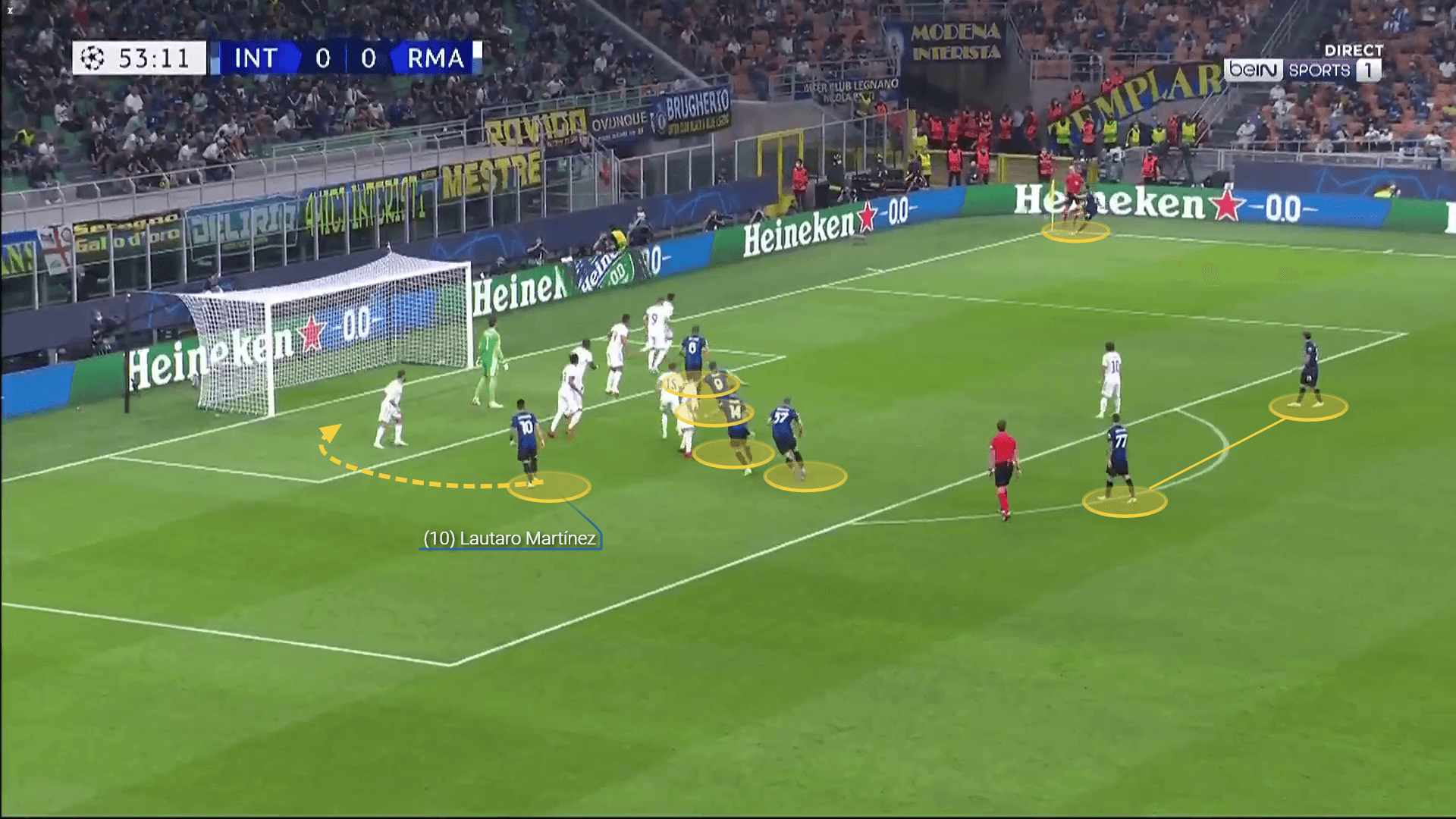
Conclusion
As our analysis shows, Inzaghi made a smart decision to stick to Inter’s existing game model and implement his tactics in particular areas where he felt enhancement was needed. He built on a team that is already successful in his favoured 3-5-2 formation and brought some valuable players that could fill in the gaps left by Lukaku and Hakimi.
Trying to dominate but also knowing when to give away the initiative and use their counter-attacking skills is very important in Nerazzurri’s current style of play. Their more balanced squad resulted in starting their season strong and with growing confidence that might help them in their title defence.

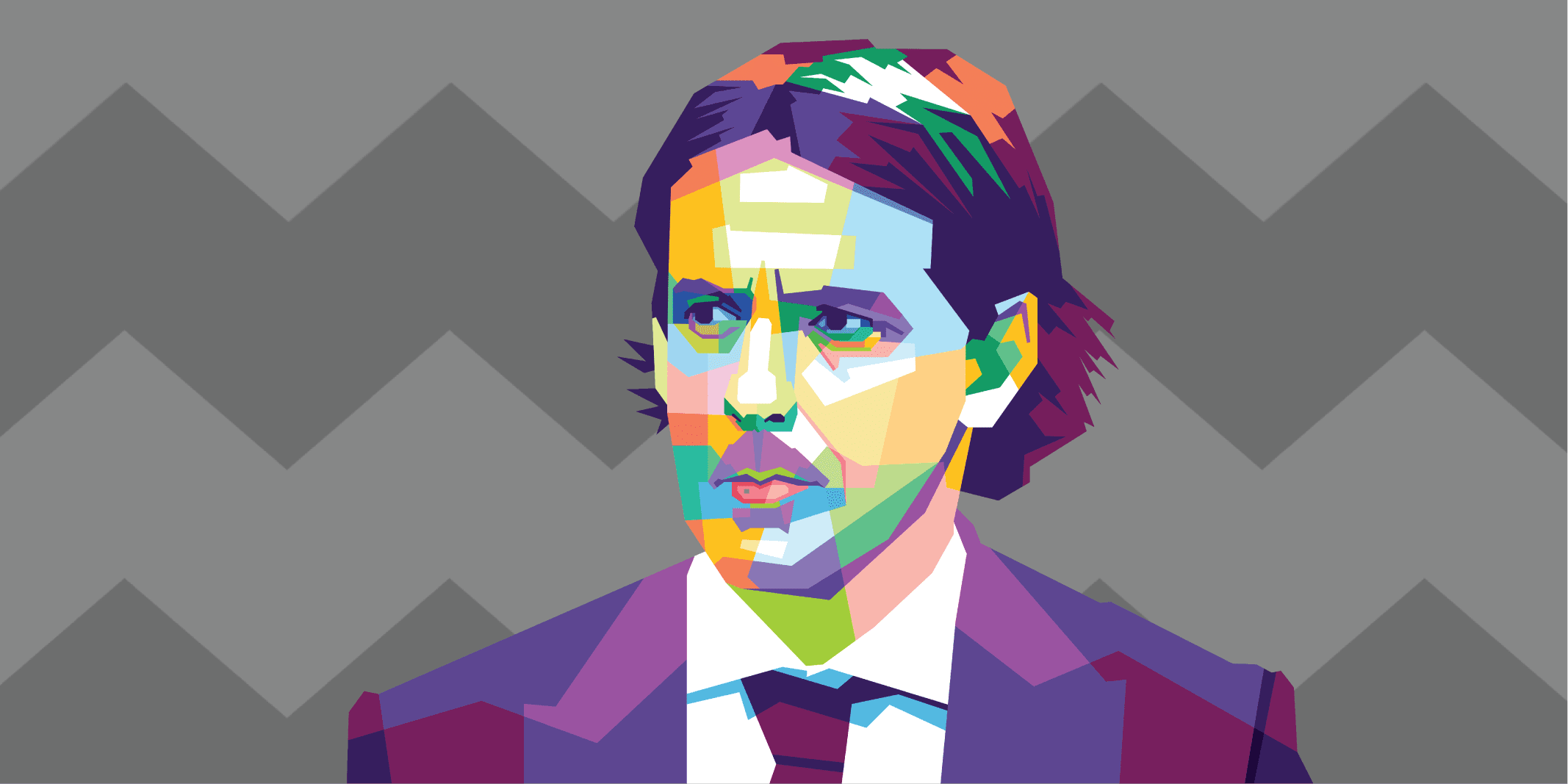




Comments